|
|
|
|
|
Intel 6xx Series and 3.73GHz Extreme Edition CPUs |
|
Join the community - in the OCAU Forums!
|
Introduction, Cache, 64-bit, Thermal Monitoring 2
Intel recently launched the 6xx desktop processor series, based on the same 90nm "Prescott" core as the previous 5xx series. Unlike the previous change from 130nm Northwood to 90nm Prescott in early 2004, the 6xx series represents an upgrade adding new features, rather than a major change. Nonetheless the new 6xx series offers at least on paper some interesting new features that should improve functionality and performance. We will first have a look at the theory of these features and then find out what they deliver in reality.
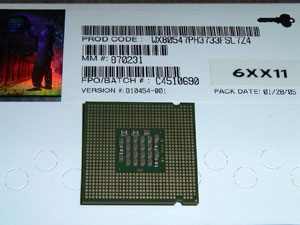
The 6xx is currently available in four clock speeds ranging from 3.0 GHz to 3.60 GHz. Additionally a new, 6xx series based "Extreme Edition" is available, clocked at 3.73 GHz. The Pentium 4 speed crown remains therefore for the time being with the 570 clocked at 3.80 GHz. Due to marketing reasons Intel is obviously holding back the 670 clocked at 3.80 GHz.

MORE CACHE: 2 MB L2 CACHE:
Although the core is very similar between the 5xx and 6xx series, there is one major change: Intel has enlarged the L2 cache size. The 5xx series comes with 1 MB L2 cache while the 6xx series processor sports 2 MB. The additional memory of course needs more physical space. The processor die size increased therefore from 112 to 135 mm≤ and the number of transistors went up from 125 to 169 million. The picture below shows on the left hand side a 1 MB Prescott core and on the right hand side a 2 MB core. The comparison shows about how much the core has been enlarged to accommodate 1 MB additional memory visible as blocks at the lower part of the die.
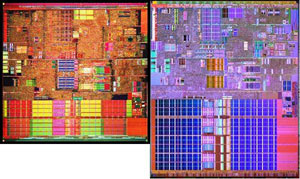
The following CPU-Z screenshots show the cache size in the 3 different configurations. Left is the 3.45 GHz EE with a 2 MB Gallatin core. Centre is the 5xx series with a 1MB Prescott core and right shows the 2MB Prescott core used for the 6xx series and 3.73 GHz EE.
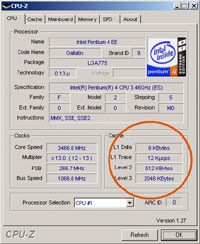 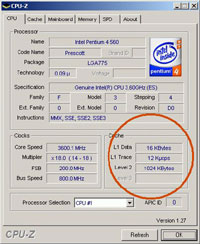 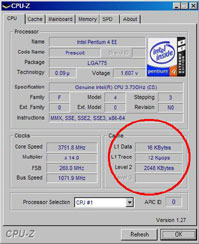
The extremely fast on-die L2 memory is used as a buffer for quick data access. Without the cache memory, every time the CPU needed data it would send a request to the main memory which would then be sent back across the memory bus to the CPU. This is a slow process in computing terms. Adding cache is a relatively simple way to improve processor performance without major changes to the architecture. In previous tests we have shown that that impact of an additional 1 MB of cache is limited to around 6%. It depends on the job the CPU is processing, to which extent cache is utilized and whether a larger amount of it is benefical. As we will later show in some cases the 5xx series 1 MB L2 offers enough space for the data-set to fit in. Enlarging the cache size does therefore not automatically mean that performance improves. One minor disadvantage of the larger cache is higher latency, because a bigger cache requires more time to find the stored data.
ENHANCED 64-BIT TECHNOLOGY (EM64T):
Probably the most important new feature of the 6xx series is that the 64-bit capability has been enabled. 64-bit capability was obviously always present on Prescott based Pentium 4, but kept dormant for regular desktop Prescott. Intel has in fact been selling 64-bit enabled Prescott since mid 2004. These 64-bit enabled Prescott "F" were sold only on demand to OEM like DELL, NEC, etc or system integrators for workstations and were otherwise difficult to get. Prescott-based 64-bit enabled Xeons (Nocona) however were selling in great numbers since July 2004. The same EM64T technology that was already available with Prescott "F" and Nocona has now been implemented on the new 6xx series.
AMD has been offering 64-bit capability since the launch of their A64 desktop series for a much longer time already. The usage of this feature however was very limited so far. Only Linux users and Windows XP 64-bit beta testers could utilize it. With the expected retail launch of Windows XP 64-bit later this year this will change, and that is the reason why Intel has now enabled 64-bit for their 6xx series desktop processors. Unlike Intelís Itanium IA-64 technology, EM64T is backward compatible: as with AMD's 64-bit technology it allows running 32-bit applications in a 64-bit environment. This is vital for helping the market make the transition to 64-bit.
THERMAL MONITORING 2 (TM2):
Thermal Monitoring is a safety feature to prevent damage to the processor from overheating. The original Thermal Monitoring was implemented with the first (Willamette) Pentium 4 core. When a critical operating temperature is reached, TM blocks clock signals to the CPU and thus reduces its power dissipation. If this is not enough to prevent damage to the processor, TM cuts off power to the CPU entirely. Naturally TM does, if it kicks in, reduce processor performance substantially. Willamette and Northwood were relatively cool running and TM rarely kicked in. It basically provided a last line of defense in case the heatsink fan stopped working or the heatsink itself fell off the core. Prescott however pushed the performance and temperature envelope further than its predecessors and TM kicked in more often with the annoying side-effect of abruptly reducing performance. TM2 is addressing this problem by not simply cutting out clocks to the CPU, but by reducing first the frequency itself down to 2.8 GHz when a certain temperature level is reached, and then reducing the voltage. Only if this does not help, then cycles are cut out and finally the entire system is shut down. TM2 is therefore not resulting in the sudden and dramatic loss of performance that TM1 could trigger. TM2 is by the way already implemented on older 5xx series "J" type processors. According to the 6xx series technical documentation TM2 is currently only implemented on the 660 clocked at 3.60 GHz. It can be disabled in the motherboardís BIOS, but the user can not manipulate the thermal threshold at which it triggers.
|
|
Advertisement:
All original content copyright James Rolfe.
All rights reserved. No reproduction allowed without written permission.
Interested in advertising on OCAU? Contact us for info.
|

|


